Cinefantastique, April 1997
Lost Highway Article
David Lynch
On Lost Highway
A surreal meditation on love, jealousy, identity and reality.
By Frederick Szebin and Steve Biodrowski
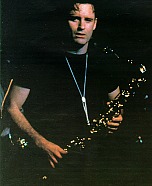 David Lynch. The name is
synonymous to film-goers
around the world with the
cinema of the abstract, the
surreal, and the obtuse. The
director of ERASERHEAD,
DUNE, and BLUE VELVET,
offers his first feature since
TWIN PEAKS: FIRE WALK
WITH ME. This latest work,
LOST HIGHWAY, is a dual-storied (or is it the same story?),
noirish tale of lust and murder.
David Lynch. The name is
synonymous to film-goers
around the world with the
cinema of the abstract, the
surreal, and the obtuse. The
director of ERASERHEAD,
DUNE, and BLUE VELVET,
offers his first feature since
TWIN PEAKS: FIRE WALK
WITH ME. This latest work,
LOST HIGHWAY, is a dual-storied (or is it the same story?),
noirish tale of lust and murder.
Or is it?
Lynch co-wrote the script
with Barry Gifford, whose
novel Wild at Heart, provided
the basis for the director's
1990 motion picture. Bill
Pullman (INDEPENDENCE
DAY) stars with Patricia
Arquette (ED WOOD),
Balthazar Getty (MR. HOLLAND'S OPUS), Robert
Loggia (INDEPENDENCE
DAY), Robert Blake (IN
COLD BLOOD), Gary Busey
(SILVER BULLET), and
Richard Pryor (STIR
CRAZY). The film received a
limited release in February,
with a nationwide release in
March.
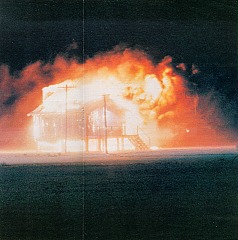 LOST HIGHWAY follows
Fred Madison (Pullman), a jazz-musician convicted of murdering his wife, Renee (Arquette).
But this plot mutates (along
with its protagonist) into the
story of Pete Dayton (Getty), a
young mechanic who may or
may not be another version of
Fred, who carries on a dangerous liaison with the mistress of
a gangster (also played by
Arquette who). This all takes
place in an imaginary Los
Angeles that seems to have
emerged from a parallel universe, and is overseen by the
Mystery Man (Blake), a ghostly figure who may (or may not)
have supernatural powers. Film
noir, German Expressionism,
and French New Wave meld to
create a story that may never
have happened, could be a
dream, or a representation of
madness.
LOST HIGHWAY follows
Fred Madison (Pullman), a jazz-musician convicted of murdering his wife, Renee (Arquette).
But this plot mutates (along
with its protagonist) into the
story of Pete Dayton (Getty), a
young mechanic who may or
may not be another version of
Fred, who carries on a dangerous liaison with the mistress of
a gangster (also played by
Arquette who). This all takes
place in an imaginary Los
Angeles that seems to have
emerged from a parallel universe, and is overseen by the
Mystery Man (Blake), a ghostly figure who may (or may not)
have supernatural powers. Film
noir, German Expressionism,
and French New Wave meld to
create a story that may never
have happened, could be a
dream, or a representation of
madness.
If you expect the film's ultimate meaning to be defined by
its director and co-writer,
you'd be sorely disappointed.
While talking about his latest
film, Lynch prefers to be vague
about its meanings, choosing to
emphasize the effectiveness of
cinema as an art form, rather
than commenting on the meaning of his own work.
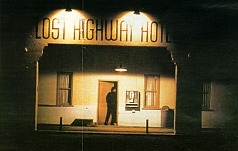 "I had been thinking about
identity," he said. "This came
up in my discussions with
Barry Gifford and is one of the
things LOST HIGHWAY is
about." Which is as concrete as
the director is likely to be.
"I had been thinking about
identity," he said. "This came
up in my discussions with
Barry Gifford and is one of the
things LOST HIGHWAY is
about." Which is as concrete as
the director is likely to be.
This is the first time Gifford
and Lynch collaborated on a
script face to face (Lynch adapted WILD AT HEART on his
own). "It was great," Lynch
says of actually writing with
Gifford. "Everybody is different. When you have Person A
writing with Person F, it goes a
certain way. And if Person A
writes with Person G, it goes
another way. The interaction is
based on the individuals in their
room, and the process is interesting. I trust Barry's instincts.
We like similar things and had a
great time."
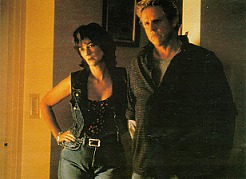 For a film steeped in technique and style, its origins were
surprisingly low-tech. Gifford,
who does not use a word
processor, said he "would just
write on long, yellow legal tablets, and an assistant would
type it up. We're both very hard
workers, and we concentrate
well. We begin, and we just go
through it and knock ourselves
out."
For a film steeped in technique and style, its origins were
surprisingly low-tech. Gifford,
who does not use a word
processor, said he "would just
write on long, yellow legal tablets, and an assistant would
type it up. We're both very hard
workers, and we concentrate
well. We begin, and we just go
through it and knock ourselves
out."
Gifford calls Lynch's film
of WILD AT HEART "
great big dark musical
comedy. What David
managed to keep was the
focus, the tenderness between
Sailor and Lula, the integrity
it also inspired him to go of
into different directions."
Judging from those differences between the novel and
the film, one might assume that
LOST HIGHWAY fit a similar
pattern, with Gifford supplying
a basic, solid narrative, and
Lynch inserting those identifiably Lynchian touches.
Actually, both writers claim
the collaboration was far more
integral than that. According to
Lynch, when one of them came
up with an idea, it was instantly reshaped by the other
person, then checked and re-checked by each other. One
idea can have repercussions on
what has come before, and all
previous work had to be
changed because of it. Lynch
referred to the collaboration as
"an unfolding, beautiful
process."
Gifford concurred, saying,
"I really wouldn't work with
anybody I don't respect. That
doesn't mean you always love
the result. But in this case, it's a
challenge." That challenge consisted of trusting Lynch to
visualize the outrageous ideas they
were putting on paper. "There's
a thing, where Michael Massee
as Andy gets stuck on the
table-that's so amazing the
way David filmed it!" Gifford
enthused. "We wrote it, thinking, 'If a guy launched himself
at somebody like that, could his
head get embedded?'
Remember how your mother
told you to be careful around
the comers of a glass table? We
were taking that fantasy, like
'Don't play with that BB gun;
you'll shoot your eye out.' It's
the same kind of thing: what's
the most horrific thing that
could happen, and could it really happen? David said, 'Don't
worry about it; just write it. I'll
worry about how to make it
happen.' Having complete confidence in him that way is very
liberating."
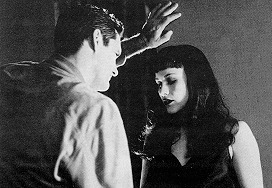 As horrible as this particular
image is, the precision of the
execution renders it almost
comic, in a strange way. "It's
all just fantastic," said Gifford.
"It's sort of beyond black
humor. Because we had this
freedom of being in a fantasy
world, more or less, we could
do anything. If spaceships came
down, which they practically
did, it wouldn't be out of context, given where we're at.
That's a tremendous structure; I
don't know if everyone understood it once we sprang it on
them."
As horrible as this particular
image is, the precision of the
execution renders it almost
comic, in a strange way. "It's
all just fantastic," said Gifford.
"It's sort of beyond black
humor. Because we had this
freedom of being in a fantasy
world, more or less, we could
do anything. If spaceships came
down, which they practically
did, it wouldn't be out of context, given where we're at.
That's a tremendous structure; I
don't know if everyone understood it once we sprang it on
them."
Indeed, many have been perplexed by LOST HIGHWAY.
Gifford, however, insists that
there is a completely rational
explanation for the apparently
surreal events on screen. [See
sidebar] According to Gifford,
Fred Madison is suffering a
kind of psychological fugue, a
condition in which a person creates another identity for himself. This is manifested in the
film when Fred literally transforms into Pete, a younger character with his own identity and
past history, for the film's second plot. This is far too much
analysis for Lynch, who prefers
to leave interpretation to viewers.
"Barry may have his idea of
what the film means," said
Lynch, "and I may have my
own idea, and they may be two
different things. And yet, we
worked together on the same
film. The beauty of a film that is
more abstract is everybody has a
different take. Nobody agrees
on anything in the world today.
When you are spoon-fed a film,
more people instantly know
what it is. I love things that
leave room to dream and are
open to various interpretations.
It's a beautiful thing. It doesn't
do any good for Barry to say
'This is what it means.' Film is
what it means. If Barry or anyone else could capture what the
film is in words, then that's
poetry."
Still, Lynch insists he isn't
being deliberately obtuse; he
may not favor advancing a specific interpretation, but he does
want the film open to interpretation. "There is a key in the film
as to its meaning," Lynch continued, "but keys are weird.
There are surface keys, and
there are deeper keys.
Intellectual thinking leaves you
high and dry sometimes.
Intuitive thinking where you get
a marriage of feelings and intellect lets you feel the answers
where you may not be able to
articulate them. Those kinds of things are used in life a lot, but
we don't use them too much in
cinema. There are films that stay
more on the surface, and there's
no problem interpreting their
meaning."
One key to interpreting the
film mayor may - or may not - rest in
the character known only as the
Mystery Man. Played by
Robert Blake, best known for
realistic, streetwise characters
such as BARETTA, the
Mystery Man is the first overt
moment in the film when the
picture steps beyond the
bounds of reality. He's a ghostly figure who can call himself
on the phone and possibly
direct Fate. He may even be
Fate personified or Fred's conscience. Or not.
"The Mystery Man came
from an old idea I had," said
Lynch. "I told Barry a version
of what ended up in the film. I
was halfway through the story,
and it looked like he wasn't listening to me. He just said,
'That's it!' and started writing
stuff down. The character came
out of a feeling of a man who,
whether real or not, gave the
impression that he was supernatural."
Blake may seem an odd
choice for the role, but Lynch
admires the Emmy and
People's Choice Award-winner
not only for his skill as an
actor, but for his uncompromising honesty. Wanting to work
with Blake for quite a while,
Lynch cast the actor against
type even though Blake admitted that he didn't understand
the script. "He was willing to
take a chance," says Lynch.
"Somewhere in talking and
rehearsing, there is a magical
moment where actors catch a
current, they're on the right
road. If they really catch it,
then whatever they do from
then on is correct and it all
comes out of them from that
point on."
Helping Lynch visualize
his surreal Los Angeles
were two longtime collaborators: producer-editor Mary Sweeney (BLUE
VELVET, WILD AT HEART,
TWIN PEAKS) and cinematographer Peter Deming (HBO's
HOTEL ROOM, ABC's ON
THE AIR).
A year and a half before
LOST HIGHWAY was written,
Sweeney had been preparing to
begin work on another Lynch
script. The producer didn't like
the rewrites as much as the first
draft, and told him so. "It kind
of took the steam out of his
enthusiasm for the project,"
said Sweeney. "It was a little
tough for me to be honest with
him, and it was hard for him to
take it. So, it was with no little
trepidation that I read LOST
HIGHWAY, and I ripped
through it. It was a great read,
and I was so excited in doing
it."
Sweeney is producer with
Tom Sternberg and Deepak
Nayar, who served as onset
producer, while Sweeney
picked up the reins during post-production, when her editing
skills came into play. Despite
the free-flowing nature of the
film, Sweeney admits to no
problems piecing the work
together. "Working with David
is just great," she said. "He's an
all-around filmmaker, very
involved every step of the way,
certainly in editing, which is
very important. We work
together very well. There was
absolutely no fear; I told him
what I thought all the time, and
sometimes he wasn't thrilled.
I'll make a first cut during production; he gives me many
notes and goes on his way. I'll
make the changes, and he
comes back. He had confidence
in me, and our communication
was good enough that he could
tell me what he wants, knowing
he'll get it. If it doesn't work
on the cutting end, he accepts
that. We do collaborate, but he
is very much the director in the
cutting room."
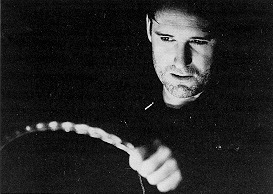 Conventional films can be
restrictive in their linear narratives, but those restrictions provide guidelines for the filmmakers to follow: the leading man
wouldn't disappear in the middle of the picture, and the film
wouldn't end in the middle of a
car chase. Still, editing LOST
HIGHWAY was not as wide
open as one might imagine.
"All of that's in the script," said
Sweeney. "David knew exactly
what he wanted, and it's
enhanced beautifully by the
way he shoots things and how
visual the film is. Working with
him and getting dailies makes
every day Christmas-all of the
crew shows up; you can't
believe what you're seeing; and
it's all so exciting. It wasn't a
walk on the wild side for me.
The film is very close to the
script.
Conventional films can be
restrictive in their linear narratives, but those restrictions provide guidelines for the filmmakers to follow: the leading man
wouldn't disappear in the middle of the picture, and the film
wouldn't end in the middle of a
car chase. Still, editing LOST
HIGHWAY was not as wide
open as one might imagine.
"All of that's in the script," said
Sweeney. "David knew exactly
what he wanted, and it's
enhanced beautifully by the
way he shoots things and how
visual the film is. Working with
him and getting dailies makes
every day Christmas-all of the
crew shows up; you can't
believe what you're seeing; and
it's all so exciting. It wasn't a
walk on the wild side for me.
The film is very close to the
script.
"What's interesting with
David is you have to cut knowing how you're going to work it
out, which I do know very
well," Sweeney continued.
"You can trust certain things
that feel awkward. He knows
exactly what he's going to do,
and it's going to be full of
sounds. David does the sound
design for LOST HIGHWAY.
You just know the footage is
going to be greatly enhanced.
It's as old as the hills in filmmaking; the way you cut a
scary sequence with music
enhances it. There are
sequences like that in the film.
The transformation from Fred
(Pullman) to Pete (Getty) has
got terrific sounds."
Musical is another element
that enhances a film, and LOST
HIGHWAY mixes existing
material from David Bowie,
Smashing Pumpkins, Trent
Reznor, Nine Inch Nails, Lou
Reed, and Marilyn Manson
(who appears in the film as
'Porno Star #1'), with an original score by Lynch collaborator
Angelo Badalamenti (BLUE
VELVET, TWIN PEAKS).
For LOST HIGHWAY,
most of the score was recorded
in Prague, with additional compositions done in London.
"David and Angelo work
together in such a way," says
Sweeney, "that long before
they went to Prague, they had a
couple sessions where they sat
down and came up with some
melodies that Angelo eventually translated to orchestral
arrangements. Some of the
music, like the end title music
by David Bowie, was chosen
by David in pre-production. He
knew right away that's what he
wanted for the end titles. Billy
Corgan, Trent Reznor and some
of that other stuff came in at the
eleventh hour, and we had to
figure out a place for them. We
actually replaced a song with a
song from Smashing Pumpkins.
"Music came in different
stages," Sweeney continues.
"All through post-production,
David listened to music. He listens to music while he thinks
about writing. It's really integral to him. He knows when
something is completely ready
and when it's not. We use temporary music tracks, but the
problem with temp tracks is
you aren't using what you want
in the end. The music will
change, and your picture
changes in how it's cut, which
changes the internal rhythm of
a scene and how it feels. We
only use temp music as part of
the process of selection. Once a
song is in there, it's pretty
much going to stay, except in
that one case."
Another important key to
the film's effectiveness
is its cinematography.
Unlike the brightly-lit
comedies Peter Deming has
worked on, such as MY
COUSIN VINNY, LOST
HIGHWAY offers a grayish,
murky world of all-encompassing darkness. During the 1940s
and 1950s, the heyday of film
noir, black-and-white film
stocks were used that were
much slower and rendered
shadows much more effectively
that color stocks.
Lynch originally hoped to
shoot LOST HIGHWAY in
black-and-white, but the financial realities of releasing a
monochrome picture to a
color-spoiled audience kept that
from happening. "In retrospect," said Deming, "I don't
think filming in black and
white would have been the
right way to go." To realize his
noirish world, Lynch let
Deming shoot LOST HIGHWAY in varying levels of darkness. The film is a little creepier than something that has contrast, with few exteriors or daylight scenes. Whenever he
could, Deming consciously
used hardly any light at all to
keep contrast down.
"There are many places in
the movie where I would normally use a back light, but didn't," Deming laughed. "So you
have people kind of melding
into the background. It's kind of
an extension of when Fred
walks down the hallway and
disappears; it's keeping that
feeling through the rest of the
movie. In another film, a director would say, 'What about a
back light? and 90-percent of
the time I'd put it there, but not
for this movie. That was kind of
fun.
"Sometimes I did things
that, in other films, would be
looked at as a mistake,"
Deming continued. "In this
film, it may have been a mistake to begin with, but you
embrace it!"-he laughed--"I
took the look as far as I could.
I've been watching David's
work since ERASERHEAD,
and had a feeling of images that
he likes, both in watching his
work and talking with him."
To ensure their planned
darkness wouldn't be 'corrected' by a well-meaning
processing lab, Deming kept in daily
contact with the lab developing
LOST HIGHWAY. He would
warn the lab that they would be
getting more of the same - either under or over exposed -
and told them not to adjust the
contrast. Deming was going for
a "thought-out" darkness based
on talks with Lynch, who usually left final lighting-or lack
of it-up to his cinematographer.
" We talked about two or
three scenes before we started shooting," Deming said.
"Basically, we just talked about
color and things like that. Once
we rehearsed a scene, we discussed how dark he wanted to
go. He would rehearse while I
watched. Then he would go
away as I lighted the scene. If
he had any comments about the
lighting, he would always mention them. Fortunately it wasn't
too often, but it did happen. It's
not something I dread. I kind of
look forward to it."
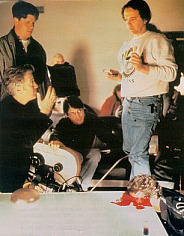 Deming relied on spot metering and cranked-down F-stops
when shooting dark scenes.
Some sequences became so dark
that viewers have to lean forward and squint to see what is
happening on screen. "I remember when Oliver Stone's JFK
came out," said Deming.
"[Cinematographer] Bob
Richardson did a lot of cool
stuff with over exposure, burning people out. I joked that
maybe I'll do the same thing
with underexposure. Somehow,
I don't think it will take off
quite as much. The thing I
wanted to achieve was giving
the feeling that anything could
come out of the background,
and to leave a certain question
about what you're looking at.
The film is working under the
surface while you're watching
it."
Deming relied on spot metering and cranked-down F-stops
when shooting dark scenes.
Some sequences became so dark
that viewers have to lean forward and squint to see what is
happening on screen. "I remember when Oliver Stone's JFK
came out," said Deming.
"[Cinematographer] Bob
Richardson did a lot of cool
stuff with over exposure, burning people out. I joked that
maybe I'll do the same thing
with underexposure. Somehow,
I don't think it will take off
quite as much. The thing I
wanted to achieve was giving
the feeling that anything could
come out of the background,
and to leave a certain question
about what you're looking at.
The film is working under the
surface while you're watching
it."
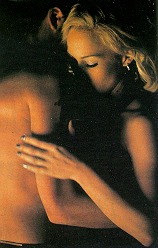 This modus operandi sets up
the Mystery Man who at first
seems almost a subliminal
presence, until he makes eye
contact and steps forward.
Another image that LOST
HIGHWAY offers to keep
viewers talking is Fred's transition into Pete. Not only do
main characters change (or do
they?), but the plot goes off
into another direction (or does
it?). Deming did several things
to visually distinguish Fred's
and Pete's stories. "Fred's story
is certainly darker than Pete's,"
Deming said. "For Pete, we did
a little more with weird compositions. To try to get inside his
head, David kept throwing the
focus out of scenes by pulling
the lens in and out while we
were shooting. I think we also
backed off the color a little bit
from the richness in the beginning of the movie. But we didn't want to drastically change
looks because for most people
who see it, the first connection
is that these two guys are the
same guy. Because of that, you
don't want to distinguish the
two sections of the film too
much."
This modus operandi sets up
the Mystery Man who at first
seems almost a subliminal
presence, until he makes eye
contact and steps forward.
Another image that LOST
HIGHWAY offers to keep
viewers talking is Fred's transition into Pete. Not only do
main characters change (or do
they?), but the plot goes off
into another direction (or does
it?). Deming did several things
to visually distinguish Fred's
and Pete's stories. "Fred's story
is certainly darker than Pete's,"
Deming said. "For Pete, we did
a little more with weird compositions. To try to get inside his
head, David kept throwing the
focus out of scenes by pulling
the lens in and out while we
were shooting. I think we also
backed off the color a little bit
from the richness in the beginning of the movie. But we didn't want to drastically change
looks because for most people
who see it, the first connection
is that these two guys are the
same guy. Because of that, you
don't want to distinguish the
two sections of the film too
much."
Pete's story comes across as
the more classically narrative
of the two (or is it just the
one?) stories. Fred's story takes
place primarily in his house,
whereas Pete's tale is a bit
more mobile. To further confuse clarity, which gleefully
seems to be Lynch's forte, Fred appears to become Pete, then
switch back again. More of the
transformation was shot than
actually used. Lynch's sensibility is not to give audiences too
much information about what is
really happening, preferring to
let them imagine details from
the snippets offered.
With all the planning, a few
happy accidents during production did catch Lynch's fancy.
One such happenstance
occurred during the rehearsal of
a dolly shot. At the end of the
rehearsal, Lynch saw the image
on a monitor as the dolly was
being brought back to its original position, while the camera
remained stationary. The director liked the resulting image
better than what was planned
and wound up using it.
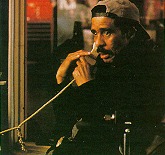 Another time, first assistant
director Scott Cameron was
changing lenses, as Lynch sat
by looking at the monitor. The
screen went from sharpness at
one focal length, to blur, to
focus, at a new focal length. He
was impressed with the image
and decided to experiment with
it while shooting. But for all
the planning and lucky breaks
in the world, filmmaking, at
best, is a perfect physical representation of Murphy's Law,
and Deming found himself
challenged by LOST
HIGHWAY's excursions outdoors, where scenes were suddenly bright and contrasty,
compared to the created murk
of the film's interiors. The
biggest challenge came with
the nighttime desert scenes,
when aesthetics became secondary to mere logistics.
Another time, first assistant
director Scott Cameron was
changing lenses, as Lynch sat
by looking at the monitor. The
screen went from sharpness at
one focal length, to blur, to
focus, at a new focal length. He
was impressed with the image
and decided to experiment with
it while shooting. But for all
the planning and lucky breaks
in the world, filmmaking, at
best, is a perfect physical representation of Murphy's Law,
and Deming found himself
challenged by LOST
HIGHWAY's excursions outdoors, where scenes were suddenly bright and contrasty,
compared to the created murk
of the film's interiors. The
biggest challenge came with
the nighttime desert scenes,
when aesthetics became secondary to mere logistics.
"The weather alternated
between cold and wind, dusty
and dirty," said Deming. "We
had a lot of different lighting
elements with us. The rig for
Fred's drive at the end was pretty elaborate; we had a semi with
two generators pulling us in
order to have enough power to
do what we needed. It was a
pretty interesting image as it
drove through the middle of
nowhere, with everything around
it black as night."
The first cut of LOST HIGHWAY ran two-and-a-half hours.
Mary Sweeney hand-picked an
audience of 50 people of varying backgrounds and ages to get
a variety of impressions. Lynch
knew the film was too long, and
realized what had to be cut, and
the comments of the 50 solidified for him what had to go,
even though some of the decisions were difficult to make.
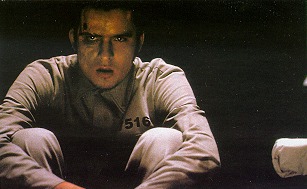 "There was a lot of stuff
about Pete's life with his buddies," said Sweeney. "There
were a couple of great scenes
that were visually so fantastic
that I hated to lose them, so we
kept them in. Pete goes out
with his friends, first to the
drive-in, then to the bowling
alley, where he's dancing with
Sheila (Natasha Gregson
Wagner), and both of those
scenes are significant. We lost
a lot in that area, and immediately after the transformation
there are a couple of things that
weren't moving the story forward. It all had to do with
Pete's life, which were scenes
that weren't going to give people the answers they were
looking for. Those scenes were just
hanging there."
"There was a lot of stuff
about Pete's life with his buddies," said Sweeney. "There
were a couple of great scenes
that were visually so fantastic
that I hated to lose them, so we
kept them in. Pete goes out
with his friends, first to the
drive-in, then to the bowling
alley, where he's dancing with
Sheila (Natasha Gregson
Wagner), and both of those
scenes are significant. We lost
a lot in that area, and immediately after the transformation
there are a couple of things that
weren't moving the story forward. It all had to do with
Pete's life, which were scenes
that weren't going to give people the answers they were
looking for. Those scenes were just
hanging there."
The film was eventually cut
down to two hours, ten minutes. An earlier scene that was
lost illustrated the tenuous relationship between Fred and his
wife. It was one of those character-revealing scenes that
could be done without. If it
happened to be a clue as to the
ultimate meaning of LOST
HIGHWAY, we'll never know.
The film is meant to cause discussion, but such films can lead
well-intentioned amateur
philosophers astray as they
lock onto insignificant scenes
or actions, thinking them to be
genuine clues. If viewers do
that with LOST HIGHWAY,
Sweeney and Lynch will be
quite pleased to have stirred the
viewer anyway.
"David sings praises to
those people," says Sweeney.
"He gives a lot of details.
People give the film a significance that tells part of their
own story, and that makes
David so happy. I've had people give very funny reactions.
There are all kinds of explanations for who Patricia Arquette
(playing both Fred's wife and
Pete's girlfriend) is; Fred is
having a dream about the type
of person he'd like to be with,
or someone he used to be with,
or she's his alter ego. People
come up with great stories and
I can't say if they're right or
wrong. Students write their
theses on David's movies-
and they write fascinating
things- but it's not what
David was thinking when he
made the film. People read a
lot into his work. I think it's
great. You stimulate
people.That's very satisfying
for an artist."
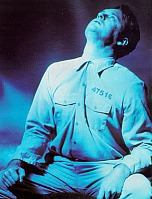 Sweeney hopes audiences will embrace
LOST HIGHWAY for
the intentionally unresolvable puzzle it was meant
to be, and don't resent the
lack of concrete answers.
Lynch's intention was to bring
dreams into the theaters that
viewers can connect with on
their own terms, not on the
filmmaker's.
Sweeney hopes audiences will embrace
LOST HIGHWAY for
the intentionally unresolvable puzzle it was meant
to be, and don't resent the
lack of concrete answers.
Lynch's intention was to bring
dreams into the theaters that
viewers can connect with on
their own terms, not on the
filmmaker's.
"David has a very strong
vision, and in other ways he's
very reckless," says Sweeney.
"He has no fear. The more
well-known you get, the more
difficult that becomes. I'm very
proud that he's still 'out there.'
He's always lamenting that he
wants to change his name, get a
wig, grow a beard, make a
movie as a complete unknown
and see how people take it. His
films are so recognizable that
he couldn't do that, but could
another person come along and
make something like this? It's
an interesting question."
Lynch's reputation certainly precedes him on everything
he does, but he finds that to be
a good thing."You find out
when you screen a movie for
people how it's going," he
says, "but you don't really
know how large a section of
the population is going to take
it. You have to check things
within yourself, let that be
your guide and hope for the
best when it's finished. The
only thing you can do is make
your film and not worry about
what will happen. Just stay
true to yourself."
Pages 32-33, 35, 37-38, 40-41
Copyright 1997 Frederick S. Clarke
Back to the Lost Highway articles page.
Lost Highway is copyright Lost Highway Productions, Three Pictures Production Company,
Asymmetrical Productions and CIBY 2000.
These pages contain information copyrighted by other individuals and entities. Copyrighted material
displayed in these pages is done so for archival purposes only and is not intended to infringe upon the
ownership rights of the original owners.
 David Lynch. The name is
synonymous to film-goers
around the world with the
cinema of the abstract, the
surreal, and the obtuse. The
director of ERASERHEAD,
DUNE, and BLUE VELVET,
offers his first feature since
TWIN PEAKS: FIRE WALK
WITH ME. This latest work,
LOST HIGHWAY, is a dual-storied (or is it the same story?),
noirish tale of lust and murder.
David Lynch. The name is
synonymous to film-goers
around the world with the
cinema of the abstract, the
surreal, and the obtuse. The
director of ERASERHEAD,
DUNE, and BLUE VELVET,
offers his first feature since
TWIN PEAKS: FIRE WALK
WITH ME. This latest work,
LOST HIGHWAY, is a dual-storied (or is it the same story?),
noirish tale of lust and murder. LOST HIGHWAY follows
Fred Madison (Pullman), a jazz-musician convicted of murdering his wife, Renee (Arquette).
But this plot mutates (along
with its protagonist) into the
story of Pete Dayton (Getty), a
young mechanic who may or
may not be another version of
Fred, who carries on a dangerous liaison with the mistress of
a gangster (also played by
Arquette who). This all takes
place in an imaginary Los
Angeles that seems to have
emerged from a parallel universe, and is overseen by the
Mystery Man (Blake), a ghostly figure who may (or may not)
have supernatural powers. Film
noir, German Expressionism,
and French New Wave meld to
create a story that may never
have happened, could be a
dream, or a representation of
madness.
LOST HIGHWAY follows
Fred Madison (Pullman), a jazz-musician convicted of murdering his wife, Renee (Arquette).
But this plot mutates (along
with its protagonist) into the
story of Pete Dayton (Getty), a
young mechanic who may or
may not be another version of
Fred, who carries on a dangerous liaison with the mistress of
a gangster (also played by
Arquette who). This all takes
place in an imaginary Los
Angeles that seems to have
emerged from a parallel universe, and is overseen by the
Mystery Man (Blake), a ghostly figure who may (or may not)
have supernatural powers. Film
noir, German Expressionism,
and French New Wave meld to
create a story that may never
have happened, could be a
dream, or a representation of
madness. "I had been thinking about
identity," he said. "This came
up in my discussions with
Barry Gifford and is one of the
things LOST HIGHWAY is
about." Which is as concrete as
the director is likely to be.
"I had been thinking about
identity," he said. "This came
up in my discussions with
Barry Gifford and is one of the
things LOST HIGHWAY is
about." Which is as concrete as
the director is likely to be. For a film steeped in technique and style, its origins were
surprisingly low-tech. Gifford,
who does not use a word
processor, said he "would just
write on long, yellow legal tablets, and an assistant would
type it up. We're both very hard
workers, and we concentrate
well. We begin, and we just go
through it and knock ourselves
out."
For a film steeped in technique and style, its origins were
surprisingly low-tech. Gifford,
who does not use a word
processor, said he "would just
write on long, yellow legal tablets, and an assistant would
type it up. We're both very hard
workers, and we concentrate
well. We begin, and we just go
through it and knock ourselves
out." As horrible as this particular
image is, the precision of the
execution renders it almost
comic, in a strange way. "It's
all just fantastic," said Gifford.
"It's sort of beyond black
humor. Because we had this
freedom of being in a fantasy
world, more or less, we could
do anything. If spaceships came
down, which they practically
did, it wouldn't be out of context, given where we're at.
That's a tremendous structure; I
don't know if everyone understood it once we sprang it on
them."
As horrible as this particular
image is, the precision of the
execution renders it almost
comic, in a strange way. "It's
all just fantastic," said Gifford.
"It's sort of beyond black
humor. Because we had this
freedom of being in a fantasy
world, more or less, we could
do anything. If spaceships came
down, which they practically
did, it wouldn't be out of context, given where we're at.
That's a tremendous structure; I
don't know if everyone understood it once we sprang it on
them." Conventional films can be
restrictive in their linear narratives, but those restrictions provide guidelines for the filmmakers to follow: the leading man
wouldn't disappear in the middle of the picture, and the film
wouldn't end in the middle of a
car chase. Still, editing LOST
HIGHWAY was not as wide
open as one might imagine.
"All of that's in the script," said
Sweeney. "David knew exactly
what he wanted, and it's
enhanced beautifully by the
way he shoots things and how
visual the film is. Working with
him and getting dailies makes
every day Christmas-all of the
crew shows up; you can't
believe what you're seeing; and
it's all so exciting. It wasn't a
walk on the wild side for me.
The film is very close to the
script.
Conventional films can be
restrictive in their linear narratives, but those restrictions provide guidelines for the filmmakers to follow: the leading man
wouldn't disappear in the middle of the picture, and the film
wouldn't end in the middle of a
car chase. Still, editing LOST
HIGHWAY was not as wide
open as one might imagine.
"All of that's in the script," said
Sweeney. "David knew exactly
what he wanted, and it's
enhanced beautifully by the
way he shoots things and how
visual the film is. Working with
him and getting dailies makes
every day Christmas-all of the
crew shows up; you can't
believe what you're seeing; and
it's all so exciting. It wasn't a
walk on the wild side for me.
The film is very close to the
script. Deming relied on spot metering and cranked-down F-stops
when shooting dark scenes.
Some sequences became so dark
that viewers have to lean forward and squint to see what is
happening on screen. "I remember when Oliver Stone's JFK
came out," said Deming.
"[Cinematographer] Bob
Richardson did a lot of cool
stuff with over exposure, burning people out. I joked that
maybe I'll do the same thing
with underexposure. Somehow,
I don't think it will take off
quite as much. The thing I
wanted to achieve was giving
the feeling that anything could
come out of the background,
and to leave a certain question
about what you're looking at.
The film is working under the
surface while you're watching
it."
Deming relied on spot metering and cranked-down F-stops
when shooting dark scenes.
Some sequences became so dark
that viewers have to lean forward and squint to see what is
happening on screen. "I remember when Oliver Stone's JFK
came out," said Deming.
"[Cinematographer] Bob
Richardson did a lot of cool
stuff with over exposure, burning people out. I joked that
maybe I'll do the same thing
with underexposure. Somehow,
I don't think it will take off
quite as much. The thing I
wanted to achieve was giving
the feeling that anything could
come out of the background,
and to leave a certain question
about what you're looking at.
The film is working under the
surface while you're watching
it." This modus operandi sets up
the Mystery Man who at first
seems almost a subliminal
presence, until he makes eye
contact and steps forward.
Another image that LOST
HIGHWAY offers to keep
viewers talking is Fred's transition into Pete. Not only do
main characters change (or do
they?), but the plot goes off
into another direction (or does
it?). Deming did several things
to visually distinguish Fred's
and Pete's stories. "Fred's story
is certainly darker than Pete's,"
Deming said. "For Pete, we did
a little more with weird compositions. To try to get inside his
head, David kept throwing the
focus out of scenes by pulling
the lens in and out while we
were shooting. I think we also
backed off the color a little bit
from the richness in the beginning of the movie. But we didn't want to drastically change
looks because for most people
who see it, the first connection
is that these two guys are the
same guy. Because of that, you
don't want to distinguish the
two sections of the film too
much."
This modus operandi sets up
the Mystery Man who at first
seems almost a subliminal
presence, until he makes eye
contact and steps forward.
Another image that LOST
HIGHWAY offers to keep
viewers talking is Fred's transition into Pete. Not only do
main characters change (or do
they?), but the plot goes off
into another direction (or does
it?). Deming did several things
to visually distinguish Fred's
and Pete's stories. "Fred's story
is certainly darker than Pete's,"
Deming said. "For Pete, we did
a little more with weird compositions. To try to get inside his
head, David kept throwing the
focus out of scenes by pulling
the lens in and out while we
were shooting. I think we also
backed off the color a little bit
from the richness in the beginning of the movie. But we didn't want to drastically change
looks because for most people
who see it, the first connection
is that these two guys are the
same guy. Because of that, you
don't want to distinguish the
two sections of the film too
much." Another time, first assistant
director Scott Cameron was
changing lenses, as Lynch sat
by looking at the monitor. The
screen went from sharpness at
one focal length, to blur, to
focus, at a new focal length. He
was impressed with the image
and decided to experiment with
it while shooting. But for all
the planning and lucky breaks
in the world, filmmaking, at
best, is a perfect physical representation of Murphy's Law,
and Deming found himself
challenged by LOST
HIGHWAY's excursions outdoors, where scenes were suddenly bright and contrasty,
compared to the created murk
of the film's interiors. The
biggest challenge came with
the nighttime desert scenes,
when aesthetics became secondary to mere logistics.
Another time, first assistant
director Scott Cameron was
changing lenses, as Lynch sat
by looking at the monitor. The
screen went from sharpness at
one focal length, to blur, to
focus, at a new focal length. He
was impressed with the image
and decided to experiment with
it while shooting. But for all
the planning and lucky breaks
in the world, filmmaking, at
best, is a perfect physical representation of Murphy's Law,
and Deming found himself
challenged by LOST
HIGHWAY's excursions outdoors, where scenes were suddenly bright and contrasty,
compared to the created murk
of the film's interiors. The
biggest challenge came with
the nighttime desert scenes,
when aesthetics became secondary to mere logistics. "There was a lot of stuff
about Pete's life with his buddies," said Sweeney. "There
were a couple of great scenes
that were visually so fantastic
that I hated to lose them, so we
kept them in. Pete goes out
with his friends, first to the
drive-in, then to the bowling
alley, where he's dancing with
Sheila (Natasha Gregson
Wagner), and both of those
scenes are significant. We lost
a lot in that area, and immediately after the transformation
there are a couple of things that
weren't moving the story forward. It all had to do with
Pete's life, which were scenes
that weren't going to give people the answers they were
looking for. Those scenes were just
hanging there."
"There was a lot of stuff
about Pete's life with his buddies," said Sweeney. "There
were a couple of great scenes
that were visually so fantastic
that I hated to lose them, so we
kept them in. Pete goes out
with his friends, first to the
drive-in, then to the bowling
alley, where he's dancing with
Sheila (Natasha Gregson
Wagner), and both of those
scenes are significant. We lost
a lot in that area, and immediately after the transformation
there are a couple of things that
weren't moving the story forward. It all had to do with
Pete's life, which were scenes
that weren't going to give people the answers they were
looking for. Those scenes were just
hanging there." Sweeney hopes audiences will embrace
LOST HIGHWAY for
the intentionally unresolvable puzzle it was meant
to be, and don't resent the
lack of concrete answers.
Lynch's intention was to bring
dreams into the theaters that
viewers can connect with on
their own terms, not on the
filmmaker's.
Sweeney hopes audiences will embrace
LOST HIGHWAY for
the intentionally unresolvable puzzle it was meant
to be, and don't resent the
lack of concrete answers.
Lynch's intention was to bring
dreams into the theaters that
viewers can connect with on
their own terms, not on the
filmmaker's.